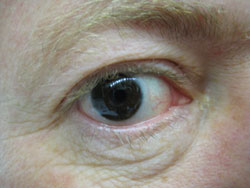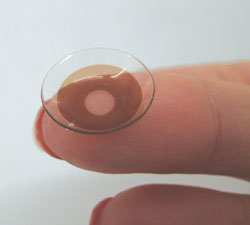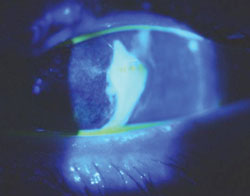Light sensitivity may indicate epithelial compromise, intraocular inflammation
Click Here to Manage Email Alerts
|
|
Aristotle is attributed as the first person to describe the photic sneeze reflex, the condition where sudden exposure to bright light stimulates sneezing. Up to a third of the population exhibits the photic sneeze reflex.
While the mechanism is not entirely understood, researchers postulate that over-stimulating the optic nerve can fool the adjacent trigeminal nerve into believing there is an irritant in the nose. Although the photic sneeze reflex is more a novelty of human physiology – arguably in the same realm as hiccups and yawning – the fact is that light can cause discomfort.
Atypical photophobia has multiple potential causes. Sometimes there is an underlying eye condition ranging from mild ocular surface disease to serious intraocular infection or trauma. Yet in the absence of ocular disease or trauma, photophobia can indicate that the patient has a reduced photophobia light threshold, meaning that the patient is just more sensitive to light.
Effective treatment of photophobia requires proper identification of the etiology. In some cases, the cause is obvious, such as if the photophobia is related to migraine headache. Perhaps the photophobia is due to iatrogenic pupil dilation by rubbing an eye after handling a scopolamine patch intended for preventing motion sickness. Yet in other situations, the cause is more elusive.
Epithelial compromise and photophobia
Breach of the corneal integrity is frequently associated with photophobia. Careful slit lamp examination with fluorescein and a Wratten filter will enhance the detection of subtle epithelial damage.
Examples of epithelial compromise include corneal abrasion, filamentary keratitis, marginal ulcer and microbial keratitis. In these instances, management of the underlying condition will alleviate the photophobia.
  Alden Optical’s soft contact lens
with a walnut #1 tint is shown on a blue iris.
Images: Alden Optical
|
|
With a corneal abrasion, a topical nonsteroidal anti-inflammatory drug and bandage soft contact lens will provide analgesia until re-epithelialization. With filamentary keratitis, ocular lubricants, punctal plugs, topical cyclosporine and other dry eye strategies are all reasonable treatments. With a marginal ulcer, a combination antibiotic-corticosteroid drop, in addition to lid hygiene, is a frequent treatment. Bacterial keratitis requires frequent dosing of antibiotics such as a newer-generation fluoroquinolone. Restoring the integrity of the corneal epithelium will reduce the patient’s photophobia.
Contact lenses can also influence photophobia. For example, a keratoconus patient with epithelial erosions from a flat-fitting gas-permeable lens may experience significant photophobia. The treatment could involve refitting the patient into a lens with greater sagittal depth to clear the cone apex or perhaps prescribing a silicone hydrogel lens for wear under the GP lens as a piggyback to prevent epithelial microtrauma.
As another example, a GP lens wearer with 3 o’clock to 9 o’clock staining may experience photophobia. In such a case, either increasing or decreasing lens diameter can reduce the corneal staining and related photophobia.
Intraocular inflammation and photophobia
Intraocular inflammation is also associated with photophobia. Causes include trauma and various forms of uveitis. Slit lamp examination should be carefully performed to detect ciliary injection and anterior chamber cell and flare, along with dilated funduscopy to evaluate any “spill-over” inflammation from the vitreous and posterior segment.
Intraocular inflammation also tends to decrease IOP due to enhanced uveal-scleral outflow of aqueous. Resolution of the intraocular inflammation will mitigate the related photophobia.
  This keratoconus patient complained of
photophobia and eye pain 1 day after undergoing intracorneal ring
implantation. The inferior segment was externalizing and migrating out of the
entry incision, with an associated epithelial defect. The implant was explanted
and the symptoms resolved.
Images: Chou B
|
|
Typical treatment of uveitis involves prednisolone acetate eye drops with cycloplegia to immobilize the ciliary body from spasm and prevent iris synechiae from forming. When trauma or history of recent ocular surgery is absent, it is important to determine if the inflammation is rooted with an infectious or autoimmune component. To that end, lab testing is often indicated and may include CBC with differential, ESR, ANA, RF, HLA-B27, ACE, PPD, FTA-ABS and RPR.
Low photophobia light threshold
In the absence of epithelial compromise, intraocular inflammation or other clinical signs, it is reasonable to conclude that the patient has a low photophobia light threshold, particularly if the symptoms have no acute onset. Treatments to attenuate intrinsic photophobia include polarized brown sunglasses, custom-tinted soft contact lenses and carotenoid supplements.
Polarized brown sunglasses
Polarized lenses are desirable because they reduce reflected glare from surfaces such as water, snow, asphalt and concrete. Scientific evidence has found that photophobia increases as the wavelength in the visible spectrum shortens. Hence, it is reasonable to believe that brown-tinted lenses, which block out the shorter wavelength blue light, can reduce photophobia.
The frame selection is also important in providing adequate eye coverage, though eye care professionals should advise patients who wear eye wear with thick temples to exercise caution while driving. As an example, the California Vehicle Code states that, “No person shall operate a motor vehicle while wearing glasses having a temple width of one-half inch or more if any part of such temple extends below the horizontal center of the lens so as to interfere with lateral vision.” Though thick temples reduce the amount of light getting to the eye, like blinders on a horse they can obstruct peripheral vision.
Custom-tinted soft contact lenses
Several companies offer custom lens tinting. I have successfully used Alden Optical for quarterly replacement hioxifilcon lenses with a walnut #1 tint in an 11-mm tint diameter and 14.5-mm lens diameter. As with sunglasses, a blue-blocking tint is theoretically desirable to reduce the short frequency light that seems most likely to induce photophobia.
It is also possible to tint soft contact lenses with an in-office system called Softchrome (www.softchrometinting.com), although reproducibility depends on the person doing the tinting and their attention to detail. With tinted lenses in general, patients should be advised that drawbacks include possible change in eye color and color distortion while wearing the lenses.
Carotenoid supplements
Zeaxanthin and lutein are both carotenoids with the same chemical formulas but slightly different molecular structures. Zeaxanthin is concentrated in the macula, while lutein is found more in the peripheral retina.
Studies have shown that zeaxanthin and lutein supplementation not only increases macular pigment optical density (MPOD) but is strongly related to improvements in glare disability and photostress recovery.
A study by Stringham and Hammond found that daily supplementation with 10 mg of lutein and 2 mg of zeaxanthin after the 4-month mark led to significant increases in MPOD and improvement in visual performance in glare for most subjects. Over the 6-month study period, supplementation led to a MPOD increase of 39% (0.16 log unit) with a resulting 58% (0.20 log unit) increased tolerance in the intensity of glaring light before losing ability to detect a central grating target.
Unusual light sensitivity requires the clinician to detect and manage any underlying epithelial compromise or intraocular inflammation. However, when these conditions are excluded and a patient’s longstanding photophobia is inconsistent with the clinical picture, treatments may include filters in the form of sunglasses, custom tinted contacts and carotenoid supplements to increase MPOD.
For more information:
- Brian Chou, OD, FAAO, is an industry consultant and private practitioner in San Diego. He is the co-developer of EyeDock.com, the online contact lens reference for eye care professionals. Dr. Chou can be reached at Carmel Mountain Vision Care, 9320 Carmel Mountain Road, Suite E, San Diego, CA 92129; (858) 484-1500; fax: (858) 484-9143; e-mail: chou@refractivesource.com; website: www.CarmelMountainVisionCare.com. Dr. Chou has no direct financial interest in the products mentioned in this article, nor is he a paid consultant for any companies mentioned.
References:
- Breitenbach RA. The photic sneeze reflex as a risk factor to combat pilots. Mil Med. 1993;158:806-809.
- Stringham JM, Fuld K, Wenzel AJ. Action spectrum for photophobia. J Opt Soc Am. 2003;20(10):1852-1858.
- Stringham JM, Hammond BR. Macular pigment and visual performance under glare conditions. Optom Vis Sci. 2008;85(2):82-88.
- Wenzel AJ, Fuld K, Stringham JM, et al. Macular pigment optical density and photophobia light threshold. Vision Res. 2006;46(28):4615-4622.
- Whitman BW, Packer RJ. The photic sneeze reflex: literature review and discussion. Neurology. 1993;43(5):868-871.

